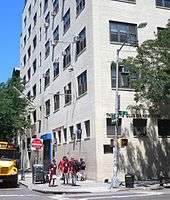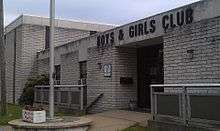Boys & Girls Clubs of America
.svg.png) Boys Club logo created from a national contest held in 1978. | |
| Motto | "To enable all young people, especially those who need us most, to reach their full potential as productive, caring, responsible citizens." |
|---|---|
| Formation | 1860 |
| Type | Youth organization |
| Legal status | Non-profit organization |
| Purpose | "Club programs and services promote and enhance the development of boys and girls by instilling a sense of competence, usefulness, belonging and influence." |
| Headquarters | Atlanta, Georgia |
Region served | United States |
Budget (2016) |
$1.85 billion (revenue) $1.73 billion (expenses)[1] |
| Website | bgca.org |


Boys & Girls Clubs of America (BGCA) is a national organization of local chapters which provide after-school programs for young people. The organization, which holds a congressional charter under Title 36 of the United States Code, has its headquarters in Atlanta, with regional offices in Chicago, Dallas, Atlanta, New York City and Los Angeles.[2] BGCA is tax-exempt and partially funded by the federal government.[3]
History
The first Boys' Club was founded in 1860 in Hartford, Connecticut by three women, Elizabeth Hamersley and sisters Mary and Alice Goodwin.[4] In 1906, 53 independent Boys' Clubs came together in Boston to form a national organization, the Federated Boys' Clubs. In 1931, the organization renamed itself Boys' Clubs of America, and in 1990, to Boys & Girls Clubs of America. As of 2010, there are over 4,000 autonomous local clubs, which are affiliates of the national organization. In total these clubs serve over four million boys and girls. Clubs can be found in all fifty states as well as locations in Puerto Rico, the Virgin Islands, and US military bases. In total, Boys & Girls Clubs of America employ about 50,000 staff members.[5]
The Chronicle of Philanthropy ranked Boys & Girls Clubs of America number one among youth organizations for the 13th consecutive year, and number 12 among all nonprofit organizations. The Boys & Girls Clubs of America is the official charity of Major League Baseball.[6] Denzel Washington, a former club member, has been the spokesperson for Boys & Girls Clubs of America since 1993.
Reach and size
As of 2012, Boys & Girls Clubs of America served some 4 million youth through club membership and community outreach. There are 4,074 chartered Club facilities, including approximately: 1,400 in schools; 400 BGCA-affiliated youth centers on U.S. military installations; 300 in public housing and 200 on Native American lands.
| Ages & Gender | Ethnicity |
|---|---|
|
|
Founders
Boys Clubs of America, 1956
These people came together in 1956 to create the Boys Clubs of America:[7]
- Herbert Hoover, 31st President of the United States
- William E. Hall, US Medal of Honor recipient
- Albert L. Cole, CEO of Reader's Digest
- James A. Farley, United States Postmaster General
- Albert C. Wedemeyer US Army Chief of Plans and Operations
- Matthew Woll, vice president of the AFL-CIO
- Jeremiah Milbank Jr., two time Republican Party Finance Committee chairman
- Stanley Resor, Secretary of the Army
- James B. Carey, president of AFL-CIO
- J. Edgar Hoover, director of the Federal Bureau of Investigation
- Lewis L. Strauss, chairman of the Atomic Energy Commission
- Robert E. Wood, quartermaster general of the army, vice-president of Sears
- Fred C. Church Jr., insurance businessman
- H. Bruce Palmer, president of the Mutual Benefit Life Insurance Company
- Edgar A. Guest, TV and radio host
- Nicholas H. Noyes Indianapolis, Indiana; oil mogul
- George A. Scott, president, Walker-Scott Company
- E. E. Fogelson, Army colonel and cattle and oil baron
- Ernest Ingold, San Francisco, California
- Jesse Draper, Atlanta, Georgia
- Julius Epstein, Chicago, Illinois
Boys & Girls Clubs of America, 1990
In 1990, Boys Clubs of America was succeeded by Boys & Girls Clubs of America, which was founded by the following people:
- Gerald W. Blakeley, Jr., Boston, Massachusetts
- Roscoe Brown, Bronx, New York, New York
- Cees Bruynes, Stamford, Connecticut
- Arnold I. Burns, New York, New York
- John L. Burns, Greenwich, Connecticut; President of the Boys' Clubs of America (1968–81), Chairman (1981–88)[8]
- Hays Clark, Hobe Sound, Florida
- Mrs. Albert L. Cole, Hobe Sound, Florida
- Mike Curb, Burbank, California
- Robert W. Fowler, Atlantic Beach, Florida
- Thomas G. Garth, New York, New York
- Moore Gates, Jr., Princeton, New Jersey
- Ronald J. Gidwitz, Chicago, Illinois
- John S. Griswold, Greenwich, Connecticut
- Claude H. Grizzard, Atlanta, Georgia
- George V. Grune, Pleasantville, New York
- Peter L. Haynes, New York, New York
- James S. Kemper, Northbrook, Illinois
- Plato Malozemoff, New York, New York
- Edmund O. Martin, Oklahoma City, Oklahoma
- Donald E. McNicol, New York, New York
- Carolyn P. Milbank, Greenwich, Connecticut
- Jeremiah Milbank, New York, New York
- C. W. Murchison III, Dallas, Texas
- W. Clement Stone, Lake Forest, Illinois
Notable members
Some notable members of the Boys & Girls Clubs of America[9]
- Ashanti
- General Wesley Clark
- Donnie Copeland
- Misty Copeland
- Lee Corso
- John Paul DeJoria
- John Duren
- Anthony Ervin
- Don Fisher
- Edward Furlong
- Cuba Gooding Jr.
- Natalie Gulbis
- Hulk Hogan
- Evander Holyfield[10]
- Earvin "Magic" Johnson
- Jackie Joyner-Kersee
- Dante Lauretta
- Paul "Triple H" Levesque
- Jennifer Lopez
- Mario Lopez
- Vince McMahon
- Ne-Yo
- Edward James Olmos
- Shaquille O'Neal
- Sugar Ray Leonard
- Smokey Robinson
- CC Sabathia
- Adam Sandler
- Martin Sheen
- Usher
- Courtney B. Vance
- Denzel Washington
- Kerry Washington
- Shaun White
- Katy Perry
Donations Received
Following the success of Black Panther, Disney donates $1 million to Boys & Girls Clubs of America for the development of STEM programs in the United States[11]. The donation will be allocated to help grow the group’s national STEM (Science, Technology, Engineering and Mathematics) curriculum. It will also help in establishing new STEM centers of innovations in various communities that will include Atlanta, Baltimore, Chicago, New York City's Harlem, Hartford, Memphis, New Orleans, Orlando, Philadelphia, Washington, Watts in Los Angeles and Oakland.[12]
According to Mimi LeClair, President and CEO of Boys and Girls Clubs of Chicago, it is very important for young people to have a solid background in STEM to compete in the global economy.[13]
See also
References
- ↑ https://www.forbes.com/companies/boys-girls-clubs-of-america/
- ↑ "Mad._Sq_AR_FINAL_reference.pdf" (PDF). Boys & Girls Clubs- Madison Square. 17 Mar 2014. Archived from the original (PDF) on 2013-10-29. Retrieved 19 Apr 2014.
- ↑ "Home - Madison Square Boys & Girls Club" (PDF). Madison Square Boys & Girls Club. 17 Mar 2014. Archived from the original (PDF) on 2010-07-06. Retrieved 19 Apr 2014.
- ↑ Kofi, Lomotey (2010). Encyclopedia of African-American Education. Greenwood Publishing Group. p. 111. ISBN 9781412940504.
- ↑ Boys & Girls Clubs of America, Boys & Girls Club Leadership University. "COREv2: History of the Boys & Girls Club."
- ↑ "MLB Community: Programs: Boys and Girls Clubs of America". MLB Advanced Media, L.P. 19 Jun 2012. Retrieved 19 Apr 2014.
- ↑ "Title 36 -- Patriotic Societies and Observances". US Congress. 11 May 1994. Retrieved 19 Apr 2014 – via resource.org.
- ↑ "John L. Burns, 87, Former Head of Boys Club", The New York Times, retrieved September 1, 2015
- ↑ Great Futures Start Here. (n.d.). Retrieved June 3, 2013, from "Archived copy". Archived from the original on 2011-11-24. Retrieved 2011-11-14.
- ↑ "Evander Holyfield". Alumni Hall of Fame. Boys & Girls Club of America. Archived from the original on 2014-12-30. Retrieved 2015-03-17.
- ↑ Gibbs, Alexandra (2018-02-27). "In honor of 'Black Panther' success, Disney donates $1 million to Boys & Girls Clubs of America for development of STEM program". CNBC. Retrieved 2018-02-28.
- ↑ "Donations will help establishing STEM centers of innovation in various communities". Mail Online. Retrieved 2018-02-28.
- ↑ "Solid STEM background is important for youth to compete in the global economy". ABC7 Chicago. 2018-02-26. Retrieved 2018-02-28.